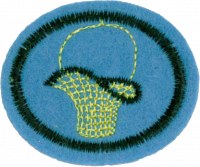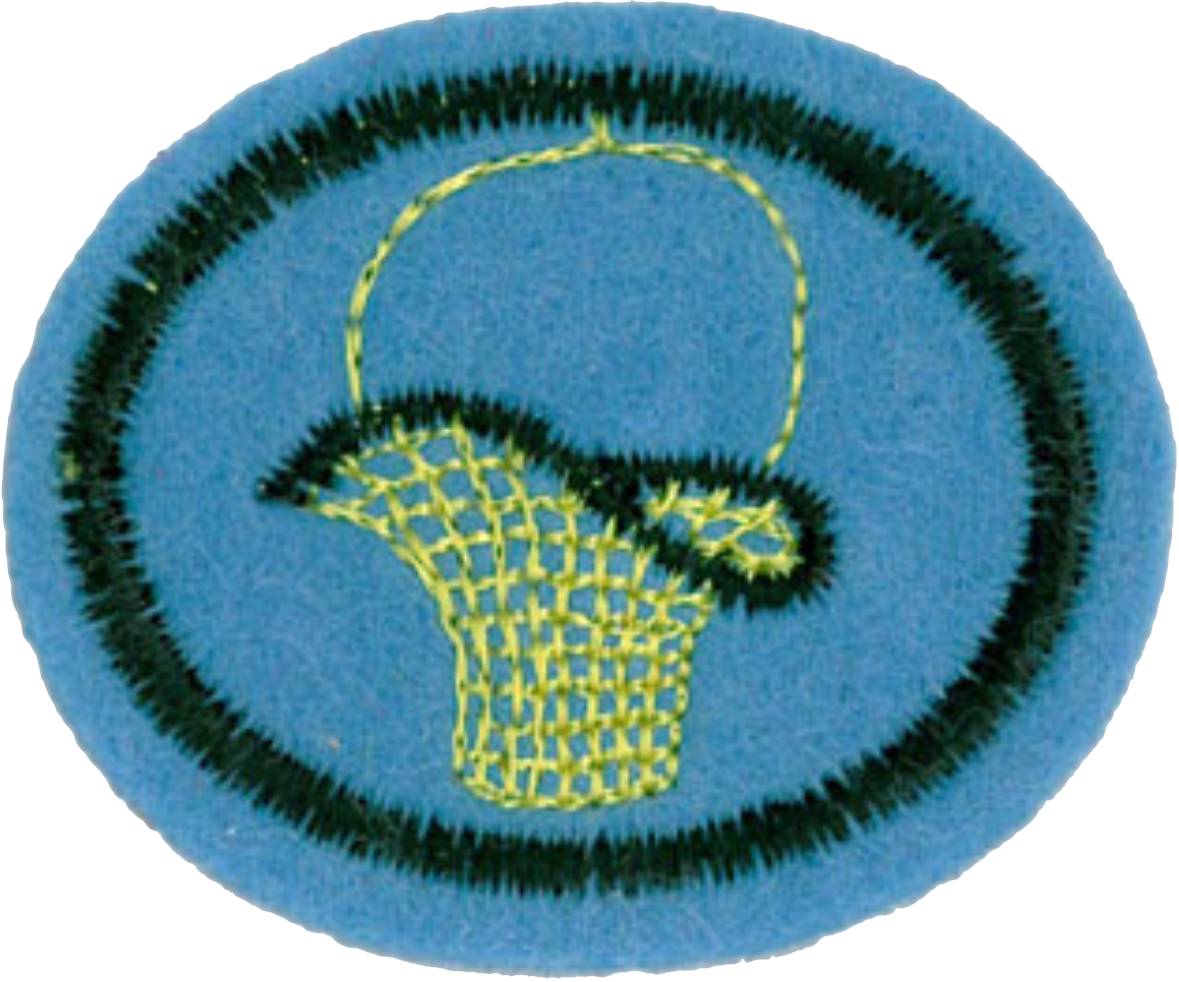Difference between revisions of "AY Honors/Basketry/Answer Key/es"
From Pathfinder Wiki
(Created page with "</noinclude><!-- instance 1 --> <!-- 1. Conocer los nombres de dos países donde se cultiva al Ratán (caña/mimbre). -->") |
(Updating to match new version of source page) |
||
| (3 intermediate revisions by one other user not shown) | |||
| Line 8: | Line 8: | ||
{{CloseReq}} <!-- 1 --> | {{CloseReq}} <!-- 1 --> | ||
{{ansreq|page={{#titleparts:{{PAGENAME}}|2|1}}|num=2}} | {{ansreq|page={{#titleparts:{{PAGENAME}}|2|1}}|num=2}} | ||
| − | <noinclude> | + | <noinclude></noinclude><!-- instance 1 --> |
| − | </noinclude><!-- instance 1 --> | + | <!-- 2. Explicar cómo se tratan las cañas o mimbres antes de tejerlos. --> |
| − | <!-- 2. | ||
| − | |||
| − | |||
| − | + | <noinclude></noinclude> | |
| − | <noinclude | ||
| − | |||
{{CloseReq}} <!-- 2 --> | {{CloseReq}} <!-- 2 --> | ||
{{ansreq|page={{#titleparts:{{PAGENAME}}|2|1}}|num=3}} | {{ansreq|page={{#titleparts:{{PAGENAME}}|2|1}}|num=3}} | ||
| − | <noinclude> | + | <noinclude></noinclude><!-- instance 1 --> |
| − | </noinclude><!-- instance 1 --> | + | <!-- 3. Qué herramientas se necesitan para: --> |
| − | <!-- 3. | ||
{{ansreq|page={{#titleparts:{{PAGENAME}}|2|1}}|num=3a}} | {{ansreq|page={{#titleparts:{{PAGENAME}}|2|1}}|num=3a}} | ||
| − | <noinclude | + | <noinclude></noinclude> |
| − | + | Sharp knife,peg, pair of round-nosed pliers, awl, two bodkins, rapping iron to tap down the wave on heavy cane work, cane seat weaver. (Note: A blunted chisel will do instead of the rapping iron, just wind a piece of tape around the end to protect the cane.) | |
| + | |||
{{CloseReq}} <!-- 3a --> | {{CloseReq}} <!-- 3a --> | ||
{{ansreq|page={{#titleparts:{{PAGENAME}}|2|1}}|num=3b}} | {{ansreq|page={{#titleparts:{{PAGENAME}}|2|1}}|num=3b}} | ||
| − | <noinclude> | + | <noinclude></noinclude><!-- instance 2 --> |
| − | </noinclude><!-- instance 2 --> | + | <noinclude></noinclude> |
| − | <noinclude | ||
| − | |||
{{CloseReq}} <!-- 3b --> | {{CloseReq}} <!-- 3b --> | ||
{{CloseReq}} <!-- 3 --> | {{CloseReq}} <!-- 3 --> | ||
{{ansreq|page={{#titleparts:{{PAGENAME}}|2|1}}|num=4}} | {{ansreq|page={{#titleparts:{{PAGENAME}}|2|1}}|num=4}} | ||
| − | <noinclude> | + | <noinclude></noinclude><!-- instance 1 --> |
| − | </noinclude><!-- instance 1 --> | + | <!-- 4. Definir: --> |
| − | <!-- 4. | + | {{ansreq|page={{#titleparts:{{PAGENAME}}|2|1}}|num=4a}} |
| − | {{ansreq|page={{#titleparts:{{PAGENAME}}|2|1}}|num=4a}} | ||
| − | |||
| − | |||
| − | + | {{clear}} | |
| − | |||
| − | |||
| − | + | <noinclude></noinclude> | |
| − | <noinclude | ||
| − | |||
{{CloseReq}} <!-- 4a --> | {{CloseReq}} <!-- 4a --> | ||
{{ansreq|page={{#titleparts:{{PAGENAME}}|2|1}}|num=4b}} | {{ansreq|page={{#titleparts:{{PAGENAME}}|2|1}}|num=4b}} | ||
| − | <noinclude> | + | <noinclude></noinclude><!-- instance 2 --> |
| − | </noinclude><!-- instance 2 -- | ||
| − | |||
| − | |||
| − | + | <noinclude></noinclude> | |
| − | <noinclude | ||
| − | |||
{{CloseReq}} <!-- 4b --> | {{CloseReq}} <!-- 4b --> | ||
{{CloseReq}} <!-- 4 --> | {{CloseReq}} <!-- 4 --> | ||
{{ansreq|page={{#titleparts:{{PAGENAME}}|2|1}}|num=5}} | {{ansreq|page={{#titleparts:{{PAGENAME}}|2|1}}|num=5}} | ||
| − | <noinclude> | + | <noinclude></noinclude><!-- instance 1 --> |
| − | </noinclude><!-- instance 1 --> | + | <!-- 5. Explicar lo siguiente: --> |
| − | <!-- 5. | ||
{{ansreq|page={{#titleparts:{{PAGENAME}}|2|1}}|num=5a}} | {{ansreq|page={{#titleparts:{{PAGENAME}}|2|1}}|num=5a}} | ||
| − | <noinclude | + | <noinclude></noinclude> |
| − | |||
{{CloseReq}} <!-- 5a --> | {{CloseReq}} <!-- 5a --> | ||
{{ansreq|page={{#titleparts:{{PAGENAME}}|2|1}}|num=5b}} | {{ansreq|page={{#titleparts:{{PAGENAME}}|2|1}}|num=5b}} | ||
| − | <noinclude> | + | <noinclude></noinclude><!-- instance 2 --> |
| − | </noinclude><!-- instance 2 --> | + | <noinclude></noinclude> |
| − | <noinclude | ||
| − | |||
{{CloseReq}} <!-- 5b --> | {{CloseReq}} <!-- 5b --> | ||
{{CloseReq}} <!-- 5 --> | {{CloseReq}} <!-- 5 --> | ||
{{ansreq|page={{#titleparts:{{PAGENAME}}|2|1}}|num=6}} | {{ansreq|page={{#titleparts:{{PAGENAME}}|2|1}}|num=6}} | ||
| − | <noinclude> | + | <noinclude></noinclude><!-- instance 1 --> |
| − | </noinclude><!-- instance 1 --> | + | <!-- 6. Nombrar dos tipos de bases usadas en la cestería y mencionar en qué clase de cesto se puede usar cada base. --> |
| − | <!-- 6. | + | <noinclude></noinclude> |
| − | <noinclude | ||
| − | |||
{{CloseReq}} <!-- 6 --> | {{CloseReq}} <!-- 6 --> | ||
{{ansreq|page={{#titleparts:{{PAGENAME}}|2|1}}|num=7}} | {{ansreq|page={{#titleparts:{{PAGENAME}}|2|1}}|num=7}} | ||
| − | <noinclude> | + | <noinclude></noinclude><!-- instance 1 --> |
| − | </noinclude><!-- instance 1 --> | + | <!-- 7. Describir cómo colocar: --> |
| − | <!-- 7. | ||
{{ansreq|page={{#titleparts:{{PAGENAME}}|2|1}}|num=7a}} | {{ansreq|page={{#titleparts:{{PAGENAME}}|2|1}}|num=7a}} | ||
| − | <noinclude | + | <noinclude></noinclude> |
| − | |||
{{CloseReq}} <!-- 7a --> | {{CloseReq}} <!-- 7a --> | ||
{{ansreq|page={{#titleparts:{{PAGENAME}}|2|1}}|num=7b}} | {{ansreq|page={{#titleparts:{{PAGENAME}}|2|1}}|num=7b}} | ||
| − | <noinclude> | + | <noinclude></noinclude><!-- instance 2 --> |
| − | </noinclude><!-- instance 2 --> | + | <noinclude></noinclude> |
| − | <noinclude | ||
| − | |||
{{CloseReq}} <!-- 7b --> | {{CloseReq}} <!-- 7b --> | ||
{{CloseReq}} <!-- 7 --> | {{CloseReq}} <!-- 7 --> | ||
{{ansreq|page={{#titleparts:{{PAGENAME}}|2|1}}|num=8}} | {{ansreq|page={{#titleparts:{{PAGENAME}}|2|1}}|num=8}} | ||
| − | <noinclude> | + | <noinclude></noinclude><!-- instance 1 --> |
| − | </noinclude><!-- instance 1 --> | + | <!-- 8. Llevar a cabo lo siguiente: tejido simple, doble, retorcido, bordar una base de rafia. --> |
| − | <!-- 8. | + | <noinclude></noinclude> |
| − | <noinclude | ||
| − | |||
{{CloseReq}} <!-- 8 --> | {{CloseReq}} <!-- 8 --> | ||
{{ansreq|page={{#titleparts:{{PAGENAME}}|2|1}}|num=9}} | {{ansreq|page={{#titleparts:{{PAGENAME}}|2|1}}|num=9}} | ||
| − | <noinclude> | + | <noinclude></noinclude><!-- instance 1 --> |
| − | </noinclude><!-- instance 1 --> | + | <!-- 9. Realizar una bandeja de caña con una base de madera. --> |
| − | <!-- 9. | + | <noinclude></noinclude> |
| − | <noinclude | ||
| − | |||
{{CloseReq}} <!-- 9 --> | {{CloseReq}} <!-- 9 --> | ||
{{ansreq|page={{#titleparts:{{PAGENAME}}|2|1}}|num=10}} | {{ansreq|page={{#titleparts:{{PAGENAME}}|2|1}}|num=10}} | ||
| − | <noinclude> | + | <noinclude></noinclude><!-- instance 1 --> |
| − | </noinclude><!-- instance 1 --> | + | <!-- 10. Realizar una canasta para panecillos con una base tejida. --> |
| − | <!-- 10. | + | <noinclude></noinclude> |
| − | <noinclude | ||
| − | |||
{{CloseReq}} <!-- 10 --> | {{CloseReq}} <!-- 10 --> | ||
{{ansreq|page={{#titleparts:{{PAGENAME}}|2|1}}|num=11}} | {{ansreq|page={{#titleparts:{{PAGENAME}}|2|1}}|num=11}} | ||
| − | <noinclude> | + | <noinclude></noinclude><!-- instance 1 --> |
| − | </noinclude><!-- instance 1 --> | + | <!-- 11. Realizar una bandeja redonda para ollas calientes de seis pulgadas (15 cM) de diámetro, de rafia o de cestería india. --> |
| − | <!-- 11. | ||
| − | |||
| − | + | <noinclude></noinclude> | |
| − | <noinclude | ||
| − | |||
{{CloseReq}} <!-- 11 --> | {{CloseReq}} <!-- 11 --> | ||
| − | <noinclude>< | + | <noinclude></noinclude><!-- instance 4 --> |
==Referencias== | ==Referencias== | ||
| − | <noinclude | + | <noinclude></noinclude> |
| − | |||
| − | |||
{{CloseHonorPage}} | {{CloseHonorPage}} | ||
Latest revision as of 19:47, 13 July 2022
1
Conocer los nombres de dos países donde se cultiva al Ratán (caña/mimbre).
2
Explicar cómo se tratan las cañas o mimbres antes de tejerlos.
3
Qué herramientas se necesitan para:
3a
Fabricar una canasta de caña?
Sharp knife,peg, pair of round-nosed pliers, awl, two bodkins, rapping iron to tap down the wave on heavy cane work, cane seat weaver. (Note: A blunted chisel will do instead of the rapping iron, just wind a piece of tape around the end to protect the cane.)
3b
Fabricar cestas de rafia o cestas indias?
4
Definir:
4a
Chamusquina del tejedor
4b
Aplastado
5
Explicar lo siguiente:
5a
Arreglar una estaca rota
5b
Unir una varilla del tejido (junco)
6
Nombrar dos tipos de bases usadas en la cestería y mencionar en qué clase de cesto se puede usar cada base.
7
Describir cómo colocar:
7a
Un borde simple
7b
Un borde de tres varillas
8
Llevar a cabo lo siguiente: tejido simple, doble, retorcido, bordar una base de rafia.
9
Realizar una bandeja de caña con una base de madera.
10
Realizar una canasta para panecillos con una base tejida.
11
Realizar una bandeja redonda para ollas calientes de seis pulgadas (15 cM) de diámetro, de rafia o de cestería india.


